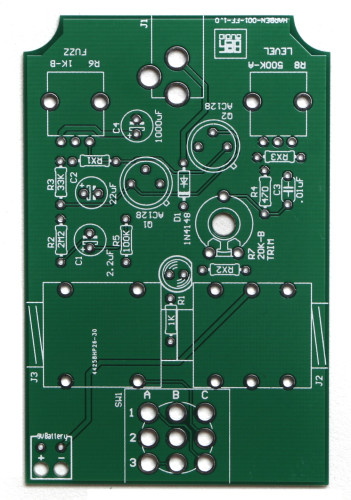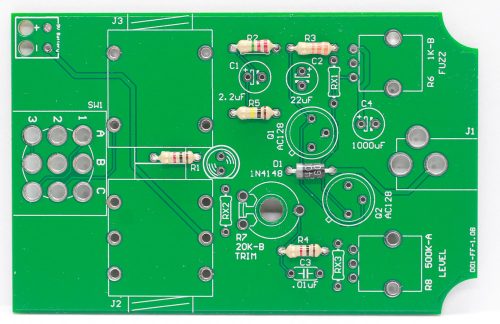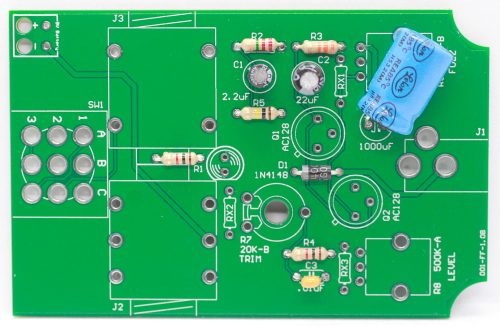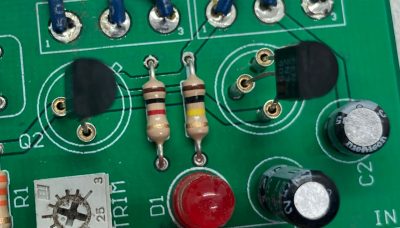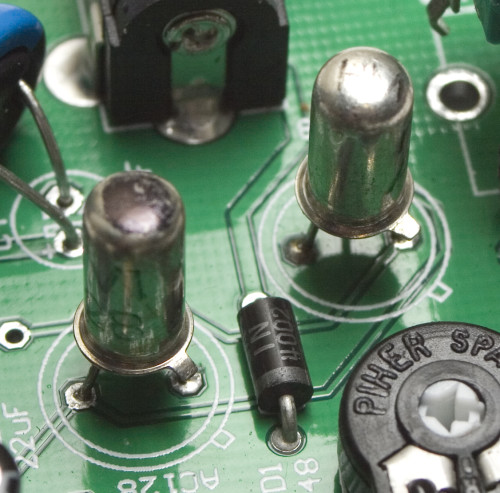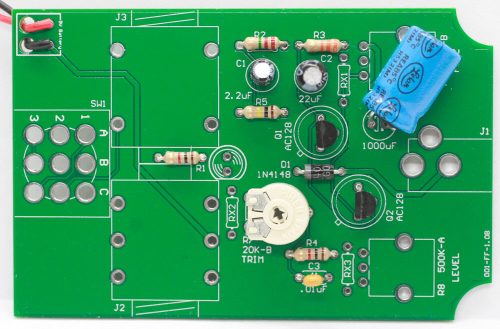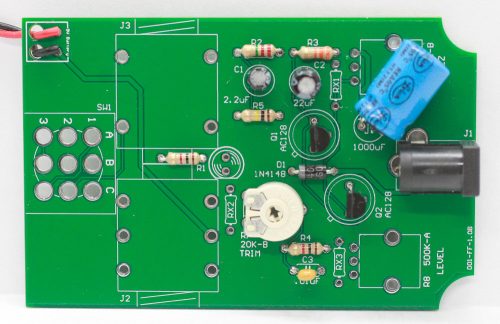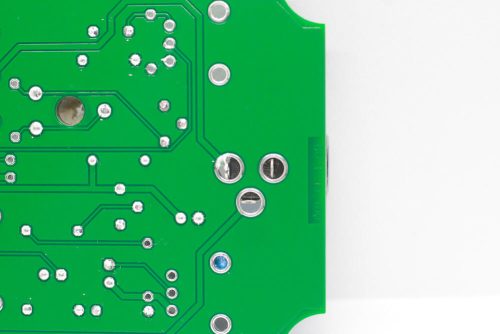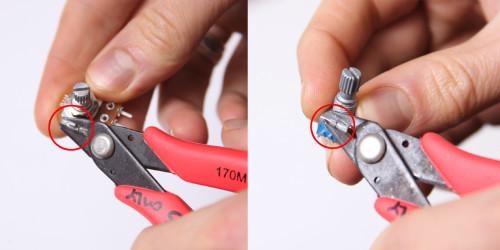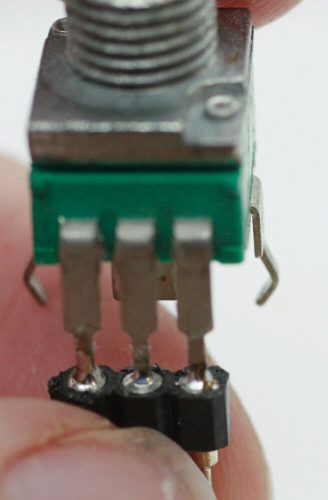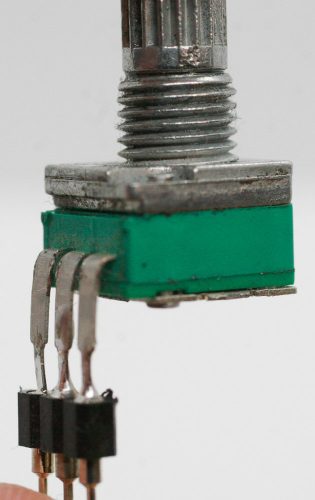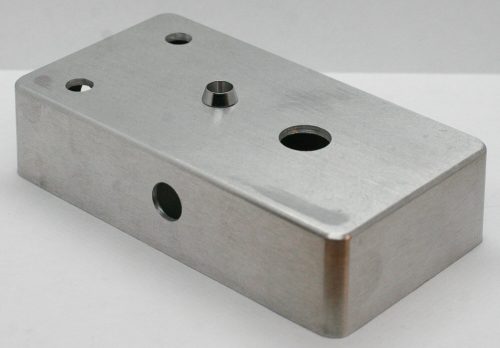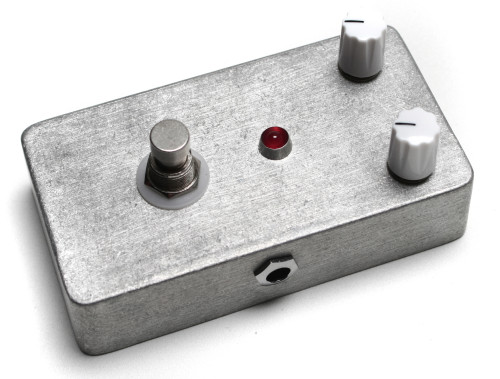Important Links
Product Page
Store Page
Assembly Instructions
Bill of Materials
Capacitor and Resistor Lookup Guide
FACE THE FUZZ PCB MOUNT VERSION
ASSEMBLY INSTRUCTIONS
Hello, and thank you for purchasing the Face the Fuzz PCB Mount DIY Kit! This page will walk you through how to build your kit and fit it into a Hammond style 1590B case.
Let’s Begin!
Resistors and Diode
First up are the resistors and Diode. Insert the resistors into their proper places according to the BOM. Then insert the Diode into place with the stripe on the diode facing the same way as the stripe on the board. Diodes are polarized components and will not work if installed improperly. Afterwards, flip your project over carefully onto a flat surface and solder everything in place. Then clip your leads.
Capacitors
Now we can populate the capacitors into the board according to the BOM. Electrolytic capacitors are polarized, so make sure when placing them, that the stripe on the capacitor goes into the hole opposite from the one marked with a ‘+’ symbol. The electrolytic caps needs to be laid on their side (as in the photo above) for them to fit inside the case. It is easiest to insert it into the holes, then push it over on its side at a diagonal so that it fits under where the potentiometer will be. Once you have populated all the capacitors, flip the board over and solder them, clipping the leads afterwards.
Transistors
FOR OLDER KITS ONLY!!
Pay special attention when placing the transistors onto the PCB. Each of the three leads has a specific function and the circuit will not work if they are placed incorrectly.
When using the silicon 2N3905 or BC558 transistors, follow the orientation in their respective photos. With the 2N3905, the ROUNDED side of the transistor should should face the tab on the silkscreen. With the BC558, the FLAT side of the transistor should face the tab on the silkscreen.
Germanium transistors: Line up the little tab on the transistor with the tab on the board as shown in the first picture above. Q1 gets the lower gain transistor (if you are using Synthrotek’s transistors, it will be marked with a black dot). Q2 gets the higher gain transistor.
9V Battery Clip and Trimmer Potentiometer
Insert the battery clip’s positive lead into the stress relief hole marked ‘+’, and then down into the solder pad next to it. repeat this with the negative lead, and then solder the wires in place. If there is any slack left in the wire between the stress relief and the solder pad, you can gently pull on the lead to remove this slack.
Insert the trimmer into the designated spot on the silkscreen, with the two legs that are closer together towards the side of the board with the stomp switch. Now you can flip the board over, solder and clip the leads (if necessary)
DC Jack
Insert the DC jack, but don’t solder it in all the way! Line the jack flush with the PCB, turn over and tack in one of the legs.
Potentiometers
The first step is to clip the chassis mount leads off of the pots, otherwise they will get in the way of the components below them. Now would also be a good time to clip any ‘nubs’ that are on the mating surface of the pots. (see below)
Next, insert the machine pin headers snugly into the pot legs.
Solder the pot legs to the pin headers.
Lastly, clip the strain relief off the bottom of the pot so that it looks like this.
Case Prep
Insert the metal LED bezel into the LED hole in the case and tighten.
Put a piece of masking tape over the top of the LED bezel.
Case Fitment and Final Soldering
For this last part, a video explains it best!
Biasing Guide:
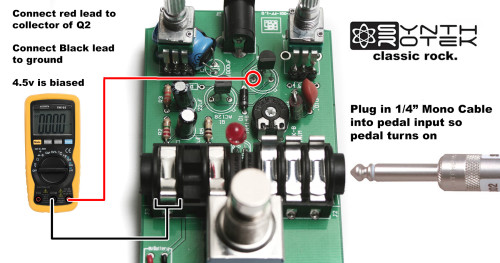
Unscrew the nuts for the input and output jacks and pull the board out of the case.
For the Fuzz Face circuit to be optimally biased, the collector of Q2 needs to be at 4.5 volts. (When connecting the Arbiter Fuzz Face Clone circuit to your multimeter as shown in the photos below your meter will read -4.5v) The 20K trim pot is used to dial in this value. You will need a multi-meter that reads DC voltage to accomplish this, which can be found very inexpensively at places like Harbor Freight Tools. All you need to do is connect your leads to a ground on the PCB and the collector of Q2 to get this reading. (Pedal must be powered on)
Completed Project
You have successfully built a Face The Fuzz Pedal! If you have any questions or concerns, feel free to contact us.
Trouble with your build? Take a look at our Troubleshooting Guide, it has lots of useful info in there that can help you get your build working right.



